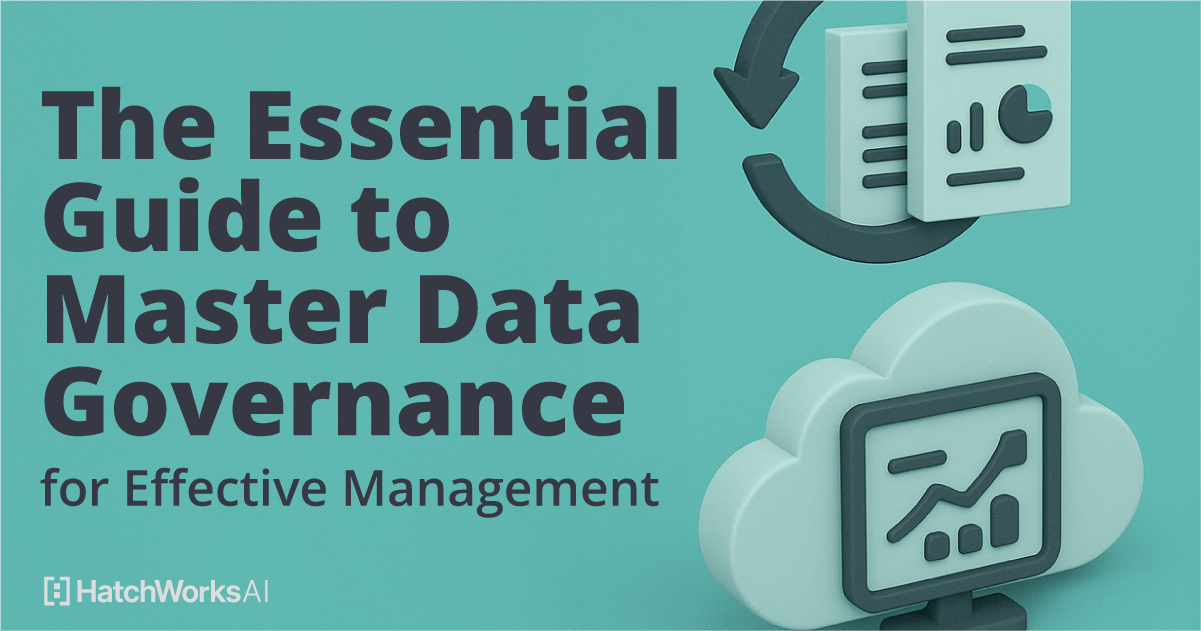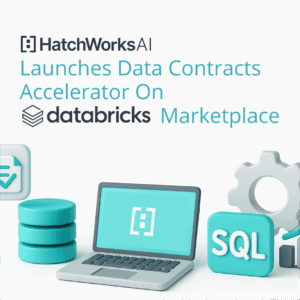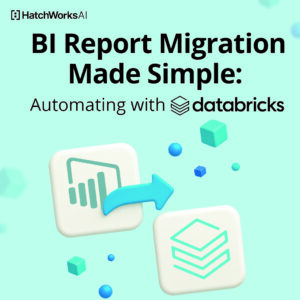No one sets out to build a messy data environment. But over time, as businesses grow, systems multiply, and teams scramble to meet daily demands, data gets tangled.
Customer records don’t match. Reports don’t align. Teams spend more time arguing over whose numbers are right than making decisions.
Master data governance is your way of taking back control.

And here’s the exciting part:
Once you have systems in place to get consistent and accurate data flowing in your organization, you can use your proprietary data (something no one else has) in your use of AI. That way, you’re not just keeping up with your competitors, you’re getting ahead.
In this guide, we’ll show you how to build a master data governance framework so you can get to the benefits of having one faster.
What Exactly Is Master Data Governance (And Why Should You Care)?
Master Data Governance is the set of policies, roles, standards, and processes that keep your organization’s most important data (or your master data) accurate, consistent, secure, and usable.
It leads nicely into another concept known as Master Data Management (MDM).
Think of it this way: Master Data Governance is your playbook.
It defines clear rules, roles, and accountability for how data should be created, handled, maintained, and shared. It’s about data policies, processes, and standards.
Master Data Management (MDM) is the execution of that playbook.
It’s the actual software tools, platforms, and technologies that store, integrate, clean, and distribute the data across your organization.
Here are some examples of master data you’ll want to govern:
- Customer master data (names, addresses, account histories, preferences),
- Product master data (descriptions, SKUs, pricing, availability), and
- Financial master data (accounts, transaction records, expense categories)
Wondering if you’re governing your data effectively?
Find out with our Data Governance Gap-to-Growth Assessment. You can quickly identify your current efforts and receive actionable, growth-focused recommendations.
The Key Components of Master Data Governance
When building a strong master data governance strategy (or rebuilding one that wasn’t working), it helps to think of it as a combination of three essential components:
- clear policies
- effective data quality management
- and defined roles and responsibilities.
Policies and Standards Everyone Adheres To
Your governance efforts won’t mean much if your policies just collect digital dust. For successful master data governance, you’ll need to craft clear, realistic policies and standards that are effortless to follow. Any roadblock and your teams will start taking shortcuts.
Many organizations use frameworks like DAMA-DMBOK (the Data Management Body of Knowledge). These frameworks have best practices that simplify policy creation, ensuring your rules are effective and easy to understand.
Management that Guarantees High Quality Master Data Every Time
Master data governance lives and dies by the quality of your data.
Why? Because without it, even the best analytics and AI initiatives become unreliable.
Some common tools and processes used to keep data quality high include:
- Data profiling and validation tools: They can quickly spot inconsistencies or missing information.
- Data cleansing processes: Used to regularly identify and remove duplicate or outdated entries.
- Monitoring and dashboards: They track quality over time, alerting your team proactively before small issues become significant problems.
Roles and Responsibilities That Keep People Accountable
Your data governance program depends heavily on clear accountability. That’s why defining and assigning specific roles is as important as having data governance in the first place.
Key roles typically include:
- Data Owners, who set policies and make high-level decisions about data use.
- Data Stewards, who handle day-to-day management, ensuring policies are followed and data remains consistent and accurate.
Clearly assigned roles and responsibilities ensure accountability, prevent costly errors, and help you quickly address problems when they occur. Everyone knows exactly who to turn to when something’s not quite right.
There are other important roles worth considering. You can find a list of them and their responsibilities in our article: Understanding Data Governance Responsibilities: A Comprehensive 2025 Guide.
Benefits of Effective Master Data Governance
Let’s look briefly at what you stand to gain when you get master data governance right:
- Improved data quality: Governance ensures your data is consistently accurate, trustworthy, and reliable. No more guessing whether a report or analytics dashboard reflects reality.
- Better decisions, faster: When everyone is working from the same trusted, consistent data, your organization can make smarter, quicker decisions. You’ll see clear insights without spending hours double-checking information.
- Operational efficiency: Governance eliminates unnecessary complexity and confusion. By getting rid of duplicate customer records, inconsistent product data, and conflicting financial reports, your operations become streamlined and productive.
- Fewer errors, more satisfied customers: Clean and consistent master data means fewer mistakes and a more reliable experience for your customers or clients.
- Stronger customer segmentation and personalization: Reliable, consistent customer data lets you segment your customers accurately, making your marketing and outreach far more effective. With trustworthy data, you know exactly who your customers are, what they want, and how best to engage them.
- Trustworthy analytics and reporting: Effective governance creates the foundation for analytics you can rely on. Because your data inputs are verified and trusted, your outputs (reports, dashboards, AI-driven insights) become valuable strategic tools rather than sources of doubt or confusion.
See It in Action: Generative AI for MDM
Watch how HatchWorks AI and Baird & Warner use GenAI to automate data deduplication and enable self-serve analytics through natural language queries with RAG. Ideal for data leaders looking to reduce manual MDM work.
Signs Your Master Data Governance Isn’t Working (Yet)
Let’s say you’ve tried to implement some sort of data governance already. How do you know if it’s failing or not?
Start by looking at your day-to-day business processes. If teams are spending valuable time manually cleaning data, hunting down missing details, or debating which numbers are correct, it’s a clear sign your governance framework has gaps. These problems also arise if you lack a framework altogether.
You might notice issues like:
- Conflicting data across departments: Sales reports don’t match what finance sees, and marketing campaigns rely on outdated customer lists.
- Duplicate records piling up: Customers, suppliers, or products showing up multiple times in your system, each with slightly different details.
- Slow, frustrating reporting cycles: Generating accurate reports takes longer than it should because data needs to be manually checked and fixed.
- Customer experience suffers: Mistakes like shipping errors or irrelevant communications stem from poor data consistency.
Seeing these signs in your business? HatchWorks’ Data Governance Gap-to-Growth Assessment is designed specifically to spot where you can improve and how. Get started now.
The Step-by-Step Framework to Get Master Data Governance Right
When you break master data governance down into actionable steps, you can build a foundation that supports your entire business strategy. Below, we’ve outlined the six steps we would take if starting from scratch.
Step 1: Start with Strategy
If you’re already thinking about what tools and tech you’ll use, hit pause. Before any of that, you need to get clear on your direction. A solid master data governance framework starts with understanding what matters most to your business.
This step has three micro-steps within it:
- Align your strategy to your business goals: What are you trying to achieve? Faster reporting? Smoother customer experiences? Regulatory compliance? Your governance strategy should directly support these outcomes.
- Define your master data. Identify the critical data categories that keep your business running—like customer records, supplier details, product catalogs, and financial accounts. This is the foundation of your efforts.
- Set realistic objectives. Don’t aim to fix everything overnight. Start with achievable goals that align with your priorities.
You can learn more about setting data governance goals here.
Step 2: Assign Clear Roles (Who’s Really in Charge?)
No governance program survives without clear accountability. Defining roles removes ambiguity and speeds up decision-making.
Key players typically include:
- Data Owners: Senior leaders who make the final calls on data decisions and strategy.
- Data Stewards: Day-to-day custodians who maintain data accuracy and consistency.
- Governance Committee: A cross-functional group that oversees progress, resolves conflicts, and keeps governance aligned with evolving business needs.
But who takes the lead? It works best when governance leadership is cross-functional. For example, we’ve seen organizations thrive when they pair technical experts with business leaders who understand how data impacts day-to-day operations.
Step 3: Create Practical Policies (That People Actually Follow)
Earlier in this article, we mentioned the importance of having policies that are easy to act on. It bears repeating.
To create practical policies, you can:
- Focus on data quality rules that are easy to follow, like standardizing customer names (“First Name, Last Name”) or ensuring all products have SKU codes in a consistent format.
- Include practical guidelines for data entry, storage, and security. For example, define how addresses should be formatted across regions, or how sensitive customer data must be protected.
- Keep it realistic. Avoid creating rules so rigid they slow your teams down—focus on clarity and usability.
Step 4: Choose Your Tech Wisely
There are plenty of master data management solutions: Informatica, Collibra, Talend, and, of course, Databricks—our preferred partner for modern, scalable data governance. With Databricks, you get a flexible architecture that supports everything from data integration to advanced analytics and AI, while keeping governance and security tightly in check.
As you make your choice:
- Choose software that integrates smoothly with your existing systems, rather than forcing a total overhaul.
- Prioritize usability. Complex tools often sit unused. Simplicity encourages adoption.
- Think about scalability. Pick solutions that can grow with your data needs.
Check out why we trust Databricks over everybody when it comes to data governance: Why We Partnered with Databricks to Help Businesses Succeed with AI.
Step 5: Start Small & Demonstrate Quick Wins
It can be tempting to overhaul everything at once, but we’d recommend starting small. When you do, you can get quick wins that build momentum.
Here are some examples of starting small:
- Cleaning up customer data to improve marketing accuracy.
- Standardizing product catalogs to reduce order errors.
- Automating duplicate record detection to clean up your CRM.
Step 6: Scale Gradually & Measure Success
Once you’ve proven the value of governance, it’s time to scale. You can expand your governance framework to cover more data domains and departments, the more wins you have.
But don’t forget to schedule periodic audits to maintain high data quality and ensure ongoing compliance.
A typical audit process might include:
- Reviewing data entries for accuracy and completeness.
Spot-checking critical fields across systems for consistency. - Evaluating adherence to your data quality rules.
- Documenting findings and creating actionable improvement plans.
Pitfalls & Problems You Want to Avoid
Here are some of the most common (and avoidable) mistakes we see, plus how to get ahead of them.
Trying to Govern Everything at Once
Ambition is great, but trying to control every piece of data right away will overwhelm your teams and stall progress. Start small. Focus first on the most critical data—like customer or product records—and expand gradually as your processes mature.
Data Silos and Fragmentation
When your data is scattered across disconnected systems, governance becomes almost impossible. Fragmented data leads to inconsistent insights and slows decision-making.
To fix this, work toward centralizing your data sources or, at the very least, ensure multiple systems can “talk” to each other through integrations. Tools like Databricks are especially powerful here, acting as a unified data layer that brings everything together cleanly.
Failing to Secure Executive Buy-in
Without leadership support, data governance initiatives struggle to get traction. Executive champions help secure resources, remove roadblocks, and drive cultural change from the top down.
Bring leadership in early, and make sure they understand how governance directly supports business goals.
Ignoring the Human Element
Policies and tools alone won’t create a culture of good data governance. People still play the biggest role. Resistance to change, internal politics, or simple confusion over responsibilities can derail even the best-designed programs. Clear communication and regular training go a long way in keeping everyone aligned.
Not Connecting Governance to Clear Business Goals
If your governance feels like an IT-only initiative, you’ll lose momentum fast. Always tie your efforts to tangible business outcomes—like improving customer experiences, speeding up reporting, or reducing operational risks.
Not Enough Supporting Resources
Effective master data governance requires dedicated time, people, and tools. Spreading your teams too thin will dilute your efforts. Be realistic about what you can take on and consider external expertise to fill in the gaps.
Evolving Regulatory Requirements
Regulations change constantly, and staying compliant can feel like a moving target. Build flexibility into your governance framework so you can adapt quickly when new requirements emerge.
Challenges with Tech Integration
New governance tools don’t always play nice with older legacy systems. Before you invest, assess compatibility and plan your integrations carefully to avoid costly technical hiccups.
Data Quality Issues
It’s a vicious cycle: poor data quality weakens governance, and weak governance leads to poor data quality. Prioritize data quality rules and build in continuous monitoring to keep your data clean and reliable.
Want to steer clear of challenges?
Our Gap-to-Growth Assessment helps you proactively spot and overcome common governance pitfalls, so you can build a data governance program that actually delivers results.
Master your Data Governance with HatchWorks AI
Ready to move beyond messy data?
At HatchWorks, we offer a straightforward Data Governance Gap-to-Growth Assessment that pinpoints exactly how your business can turn your data from a headache into a strategic asset.
Make Your Data AI-Ready
With Data Engineering & Analytics, we help you build modern, scalable systems that make your data secure, usable, and primed for AI success.




